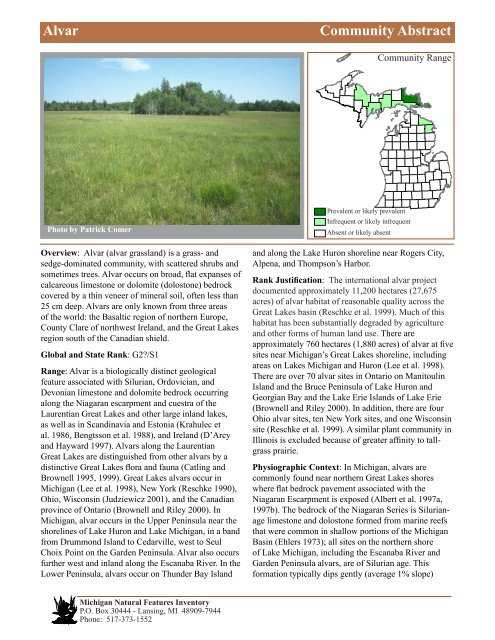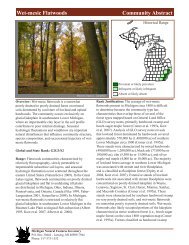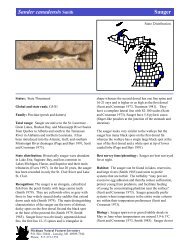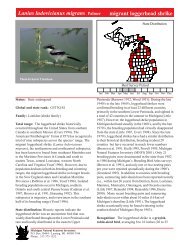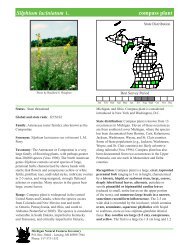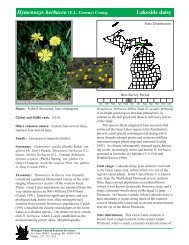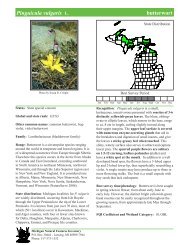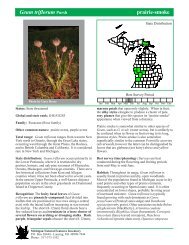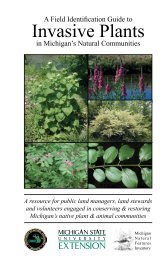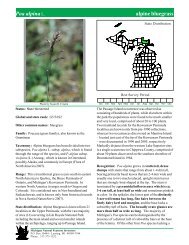Community Abstract Alvar - Michigan Natural Features Inventory ...
Community Abstract Alvar - Michigan Natural Features Inventory ...
Community Abstract Alvar - Michigan Natural Features Inventory ...
Create successful ePaper yourself
Turn your PDF publications into a flip-book with our unique Google optimized e-Paper software.
<strong>Alvar</strong><br />
Photo by Patrick Comer<br />
Overview: <strong>Alvar</strong> (alvar grassland) is a grass- and<br />
sedge-dominated community, with scattered shrubs and<br />
sometimes trees. <strong>Alvar</strong> occurs on broad, flat expanses of<br />
calcareous limestone or dolomite (dolostone) bedrock<br />
covered by a thin veneer of mineral soil, often less than<br />
25 cm deep. <strong>Alvar</strong>s are only known from three areas<br />
of the world: the Basaltic region of northern Europe,<br />
County Clare of northwest Ireland, and the Great Lakes<br />
region south of the Canadian shield.<br />
Global and State Rank: G2?/S1<br />
Range: <strong>Alvar</strong> is a biologically distinct geological<br />
feature associated with Silurian, Ordovician, and<br />
Devonian limestone and dolomite bedrock occurring<br />
along the Niagaran escarpment and cuestra of the<br />
Laurentian Great Lakes and other large inland lakes,<br />
as well as in Scandinavia and Estonia (Krahulec et<br />
al. 1986, Bengtsson et al. 1988), and Ireland (D’Arcy<br />
and Hayward 1997). <strong>Alvar</strong>s along the Laurentian<br />
Great Lakes are distinguished from other alvars by a<br />
distinctive Great Lakes flora and fauna (Catling and<br />
Brownell 1995, 1999). Great Lakes alvars occur in<br />
<strong>Michigan</strong> (Lee et al. 1998), New York (Reschke 1990),<br />
Ohio, Wisconsin (Judziewicz 2001), and the Canadian<br />
province of Ontario (Brownell and Riley 2000). In<br />
<strong>Michigan</strong>, alvar occurs in the Upper Peninsula near the<br />
shorelines of Lake Huron and Lake <strong>Michigan</strong>, in a band<br />
from Drummond Island to Cedarville, west to Seul<br />
Choix Point on the Garden Peninsula. <strong>Alvar</strong> also occurs<br />
further west and inland along the Escanaba River. In the<br />
Lower Peninsula, alvars occur on Thunder Bay Island<br />
<strong>Michigan</strong> <strong>Natural</strong> <strong>Features</strong> <strong>Inventory</strong><br />
P.O. Box 30444 - Lansing, MI 48909-7944<br />
Phone: 517-373-1552<br />
<strong>Community</strong> <strong>Abstract</strong><br />
Prevalent or likely prevalent<br />
Infrequent or likely infrequent<br />
Absent or likely absent<br />
<strong>Alvar</strong>, Page 1<br />
<strong>Community</strong> Range<br />
and along the Lake Huron shoreline near Rogers City,<br />
Alpena, and Thompson’s Harbor.<br />
Rank Justification: The international alvar project<br />
documented approximately 11,200 hectares (27,675<br />
acres) of alvar habitat of reasonable quality across the<br />
Great Lakes basin (Reschke et al. 1999). Much of this<br />
habitat has been substantially degraded by agriculture<br />
and other forms of human land use. There are<br />
approximately 760 hectares (1,880 acres) of alvar at five<br />
sites near <strong>Michigan</strong>’s Great Lakes shoreline, including<br />
areas on Lakes <strong>Michigan</strong> and Huron (Lee et al. 1998).<br />
There are over 70 alvar sites in Ontario on Manitoulin<br />
Island and the Bruce Peninsula of Lake Huron and<br />
Georgian Bay and the Lake Erie Islands of Lake Erie<br />
(Brownell and Riley 2000). In addition, there are four<br />
Ohio alvar sites, ten New York sites, and one Wisconsin<br />
site (Reschke et al. 1999). A similar plant community in<br />
Illinois is excluded because of greater affinity to tallgrass<br />
prairie.<br />
Physiographic Context: In <strong>Michigan</strong>, alvars are<br />
commonly found near northern Great Lakes shores<br />
where flat bedrock pavement associated with the<br />
Niagaran Escarpment is exposed (Albert et al. 1997a,<br />
1997b). The bedrock of the Niagaran Series is Silurianage<br />
limestone and dolostone formed from marine reefs<br />
that were common in shallow portions of the <strong>Michigan</strong><br />
Basin (Ehlers 1973); all sites on the northern shore<br />
of Lake <strong>Michigan</strong>, including the Escanaba River and<br />
Garden Peninsula alvars, are of Silurian age. This<br />
formation typically dips gently (average 1% slope)
Ecoregional map of <strong>Michigan</strong> (Albert 1995) depicting distribution of alvar (Albert et al. 2008)<br />
<strong>Michigan</strong> <strong>Natural</strong> <strong>Features</strong> <strong>Inventory</strong><br />
P.O. Box 30444 - Lansing, MI 48909-7944<br />
Phone: 517-373-1552<br />
<strong>Alvar</strong>, Page 2
toward the south into the <strong>Michigan</strong> Basin. Ordovicianage<br />
limestone and dolomite also support these plant<br />
communities on northern Drummond Island, while<br />
Devonian-age limestone occurs in Presque Isle and<br />
Alpena counties in Lower <strong>Michigan</strong>. Being formed<br />
from marine organisms, these rocks are rich in calcium<br />
carbonates. Resistance to erosion is variable; limestone<br />
and dolostone are readily dissolved by rain water,<br />
producing solution cracks or grykes that often connect<br />
to the underlying groundwater system. In contrast,<br />
argillaceous limestone rich in sand, silt, or clay from<br />
terrestrial sources is more resistant to solution and<br />
typically contains few broad cracks. <strong>Alvar</strong>s are located<br />
within sub-subsections VII.6.3, VIII.1.1, and VIII.1.3<br />
of the Regional Landscape Ecosystems as delineated<br />
by Albert (1995), where proximity to the Great Lakes<br />
results in moderated climate and high precipitation.<br />
Photo by Ted Cline<br />
<strong>Alvar</strong> within Sub-subsection VIII.1.3 occurs along the<br />
Escanaba River. In this aerial photograph, the joint patterns of<br />
the limestone can be easily seen. Vegetation establishes first in<br />
the joints and then spreads gradually across the bedrock.<br />
<strong>Alvar</strong> is characterized by shallow soil over bedrock,<br />
with soil depth usually less than 25 cm. Soil texture is<br />
primarily loamy sand or sandy loam. Soil is saturated,<br />
or locally inundated in the spring, but it becomes<br />
droughty later in the summer. Thin layers of organic soil<br />
may develop in shallow depressions that remain wet<br />
for longer periods. The soils and substrate are neutral to<br />
slightly alkaline (pH 6.7-8.0) (Kost et al. 2007).<br />
Low ridges of limestone or dolomite cobble, typically<br />
1-2 m high, commonly occur on the alvar. These ridges<br />
are remnants from an earlier post-glacial period, when<br />
the inland alvar sites were inundated by higher Great<br />
Lakes lake levels. At that time, cobble ridges were<br />
deposited by ice scour and major storm events.<br />
<strong>Michigan</strong> <strong>Natural</strong> <strong>Features</strong> <strong>Inventory</strong><br />
P.O. Box 30444 - Lansing, MI 48909-7944<br />
Phone: 517-373-1552<br />
<strong>Alvar</strong>, Page 3<br />
Photo by Patrick Comer<br />
On alvar with better drainage conditions and thicker soils,<br />
shrubs and dwarfed trees become more common, grading<br />
into limestone bedrock glade (alvar glade).<br />
Surrounding the alvar, where deeper soils developed<br />
upon the limestone, there are forests or alvar glades<br />
(also known as limestone bedrock glades) of Thuja<br />
occidentalis (northern white-cedar), Picea glauca<br />
(white spruce), Abies balsamea (balsam fir), and<br />
Betula papyrifera (paper birch). Lower portions of the<br />
landscape can be flooded by beaver dams, creating<br />
wetlands dominated by Fraxinus nigra (black ash) and<br />
many other wetland shrubs and herbs. More seasonally<br />
flooded wetlands adjacent to alvar grassland are<br />
typically dominated by northern white-cedar.<br />
<strong>Natural</strong> Processes: The presence of bedrock at or near<br />
the surface results in seasonal flooding from fall through<br />
spring, often followed by summer drought in July and<br />
August, when seasonal pools dry up and vegetation<br />
is under drought stress (Stephenson and Herendeen<br />
1986, Rosen 1995, Reschke et al. 1999). Surface<br />
temperatures can reach 43 to 53 degrees C (109 to 127<br />
degrees F) (Gilman 1995, Schaefer and Larson 1997).<br />
Glacial scour has created small, shallow depressions<br />
in the bedrock, which can flood either seasonally or<br />
year round, creating herb-, shrub-, or tree-dominated<br />
wetlands within the alvar landscape. Flooding is less<br />
prevalent where there are abundant enlarged cracks<br />
(grykes) in the rock, which provide improved internal<br />
drainage. Grykes form along naturally occurring rock<br />
joints as water rich in carbon dioxide forms carbonic<br />
acid, which causes high rates of limestone dissolution.<br />
The concentration of decomposing vegetation and<br />
respiring roots in the rock joints also contributes high<br />
levels of carbon dioxide in the rock joints, accelerating<br />
the rate of limestone dissolution. Sites with many of
these cracks that enhance internal drainage are more<br />
prone to early desiccation and drought. Many of the<br />
widest grykes occur under forest cover, probably<br />
because of denser rooting and large accumulations of<br />
decomposing vegetation.<br />
Photo by Joshua Cohen<br />
Carbonic and organic acids from decomposing vegetation<br />
and plant respiration accelerate the rate of dissolution in the<br />
structural joints of the limestone bedrock, creating broad joints<br />
called grykes.<br />
Fire, both natural and human-induced, has been<br />
documented for Great Lakes alvars in both the United<br />
States and Canada (Catling and Brownell 1998, Jones<br />
and Reschke 2005), but the fire regime is believed to<br />
be quite variable and fire is not considered important<br />
for maintaining biologically diverse alvar (Schaefer<br />
and Larson 1997, Reschke et al. 1999). Controlled<br />
burns can increase plant diversity (Catlin and Brownell<br />
1998), while wildfires sometimes greatly reduce<br />
diversity (Gilman 1997). Grazing by either native or<br />
introduced ungulates is important for reducing woody<br />
encroachment (Bengtsson et al. 1988, Titlyanova et<br />
al. 1988, Rosen 1992, 1995), while lack of grazing can<br />
result in cool-season Eurasian grasses replacing native<br />
alvar dominants (Reschke et al. 1999). Overgrazing by<br />
cattle can result in increased levels of invasive plants,<br />
reduced levels of native grasses, and increased amounts<br />
of species selectively avoided by cattle, such as<br />
Eleocharis compressa (flattened spike-rush) and some<br />
rosette forming native perennials, including Ranunculus<br />
fascicularis (early buttercup), Aster spp. (asters)<br />
and Solidago spp. (goldenrods) (Brownell 1998).<br />
<strong>Michigan</strong> <strong>Natural</strong> <strong>Features</strong> <strong>Inventory</strong><br />
P.O. Box 30444 - Lansing, MI 48909-7944<br />
Phone: 517-373-1552<br />
<strong>Alvar</strong>, Page 4<br />
Windthrown trees occur on or adjacent to the alvar<br />
because of shallow soil, poor drainage, and resultant<br />
shallow rooting of plants.<br />
Vegetation Description: <strong>Alvar</strong>s are dominated<br />
primarily by grasses and sedges, with mosses and<br />
lichens dominant in the driest areas, and scattered<br />
shrubs and occasionally trees in areas where the soil<br />
depth is greatest or where cracks or grykes provide<br />
additional moisture needed by woody vegetation<br />
(Reschke et al. 1999). Several different alvar<br />
communities are described on the basis of drainage<br />
differences, ranging from “tufted hairgrass wet alvar<br />
grassland” on the wettest sites to “juniper alvar<br />
shrubland” on the driest sites, which never flood<br />
(Reschke et al. 1999). Dominant grasses and sedges<br />
include Schizachyrium scoparium (little bluestem),<br />
Sporobolus heterolepis (prairie dropseed), and<br />
Carex scirpoidea (bulrush sedge). Where soil-water<br />
availability is greater, Eleocharis compressa (flattened<br />
spike-rush), Andropogon gerardii (big bluestem),<br />
Muhlenbergia richardsonis (mat muhly), and Spartina<br />
pectinata (cordgrass) are often dominant.<br />
Photo by Dennis Albert<br />
Shallow water often covers flat, wet alvar into<br />
the early growing season, and in some years<br />
throughout the entire growing season. This<br />
seasonal flooding restricts the growth of trees<br />
and shrubs.<br />
Characteristic plants: The following species were<br />
present in over 50% of 5 diverse alvar sites from<br />
<strong>Michigan</strong> across Canada to New York. Characteristic<br />
grasses included Agrostis hyemale (ticklegrass), Bromus<br />
kalmii (Kalm’s brome), Danthonia spicata (poverty<br />
grass), and Deschampsia caespitosa (tufted hairgrass).<br />
Sedges include Carex crawei (Crawe’s sedge), C.<br />
richardsonii (Richardson’s sedge), C. scirpoidea<br />
(bulrush sedge), and Eleocharis elliptica (goldenseeded<br />
spike-rush). Herbs included Antennaria neglecta<br />
(small-leaved pussytoes), Aquilegia canadensis (wild
<strong>Alvar</strong> is a grass- and sedge-dominated community, with scattered shrubs and sometimes trees. The<br />
community occurs on broad, flat expanses of calcareous bedrock (limestone or dolostone) covered<br />
by a thin veneer of mineral soil. Photos by Bradford S. Slaughter.<br />
<strong>Michigan</strong> <strong>Natural</strong> <strong>Features</strong> <strong>Inventory</strong><br />
P.O. Box 30444 - Lansing, MI 48909-7944<br />
Phone: 517-373-1552<br />
<strong>Alvar</strong>, Page 5
columbine), Arabis hirsuta (hairy rock cress), Arenaria<br />
stricta (rock sandwort), Campanula rotundifolia<br />
(harebell), Castilleja coccinea (Indian paintbrush),<br />
Cerastium arvense (field chickweed), Comandra<br />
umbellata (bastard-toadflax), Lepidium virginicum<br />
(common peppergrass), Monarda fistulosa (wild<br />
bergamot), Potentilla arguta (prairie cinquefoil),<br />
Ranunculus fascicularis (early buttercup), Calamintha<br />
arkansana (low calamint), Senecio pauperculus<br />
(balsam ragwort), and Solidago nemoralis (old-field<br />
goldenrod). Characteristic shrubs include Juniperus<br />
communis (common juniper), Potentilla fruticosa<br />
(shrubby cinquefoil), Rhus aromatica (fragrant sumac),<br />
Prunus virginiana (choke cherry), and Symphoricarpos<br />
albus (snowberry). Characteristic trees include Thuja<br />
occidentalis (northern white-cedar), Picea glauca<br />
(white spruce), Pinus strobus (white pine), and Populus<br />
tremuloides (trembling aspen). Cryptogram diversity<br />
(mosses, lichens, and liverworts) is also high on alvar<br />
(Marr 1997), but additional comprehensive surveys are<br />
needed.<br />
Photo by Dennis Albert<br />
Solution depressions form as rain water gradually<br />
dissolves the surface of alvar. Nostoc, an algae, grows in<br />
the larger depressions when moisture is available.<br />
Associated Species: <strong>Alvar</strong> supports many of the same<br />
species found on limestone bedrock lakeshores, with<br />
additional species, including Geum triflorum (prairie<br />
smoke) and flattened spike-rush found only at inland<br />
sites. Although prairie-like in appearance, alvars are<br />
located far northeast of the Prairie Peninsula. About<br />
half of the species with constancy above 50% are of<br />
northern distribution. Among other high constancy<br />
species, about 20% have southeastern distributions, and<br />
some species typical of upland prairies are present.<br />
<strong>Michigan</strong> <strong>Natural</strong> <strong>Features</strong> <strong>Inventory</strong><br />
P.O. Box 30444 - Lansing, MI 48909-7944<br />
Phone: 517-373-1552<br />
<strong>Alvar</strong>, Page 6<br />
Invasive Plants: Invasive plant species are common<br />
at many alvar sites. The frequency of invasives was<br />
studied at U.S. and Canadian sites (Reschke et al. 1999),<br />
with the following results: Poa compressa (Canada<br />
bluegrass) at 62% of observation points, Hypericum<br />
perforatum (St. John’s-wort) at 49%, Potentilla recta<br />
(rough-fruited cinquefoil) at 25%, Verbascum thapsus<br />
(common mullein) at 24%, Phleum pratense (common<br />
timothy) at 22%, Chrysanthemum leucanthemum (oxeye<br />
daisy) at 17%, Hieracium piloselloides (glaucous<br />
king devil) at 17%, Rumex crispus (curly-leaf dock)<br />
at 14%, Hieracium spp. (hawkweeds) at 13%, Daucus<br />
carota (wild carrot) at 11%, Echium vulgare (blueweed)<br />
at 11%, Melilotus alba (white sweet-clover) at 10%,<br />
Poa pratensis (Kentucky bluegrass) at 9%, and<br />
Rhamnus cathartica (buckthorn) at 9%. St. John’s-wort<br />
and common mullein appear to most significantly alter<br />
the composition and structure of the alvar because of<br />
their density or size.<br />
<strong>Michigan</strong> Indicator Species: Schizachyrium scoparium<br />
(little bluestem), Eleocharis compressa (flattened spikerush),<br />
Danthonia spicata (poverty grass), Deschampsia<br />
caespitosa (hair grass), Carex crawei (Crawe’s<br />
sedge), Eleocharis elliptica (golden-seeded spikerush),<br />
Campanula rotundifolia (harebell), Castilleja<br />
coccinea (Indian paintbrush), Calamintha arkansana<br />
(low calamint), Senecio pauperculus (balsam ragwort),<br />
Solidago nemoralis (old-field goldenrod), Juniperus<br />
communis (common juniper), Juniperus horizontalis<br />
(creeping juniper), Potentilla fruticosa (shrubby<br />
cinquefoil), Symphoricarpos albus (snowberry), Thuja<br />
occidentalis (northern white-cedar), Picea glauca<br />
(white spruce), and Populus tremuloides (trembling<br />
aspen).<br />
Other Noteworthy Species: Rare animals associated<br />
with alvar in <strong>Michigan</strong> include Lanius ludovicianus<br />
migrans (loggerhead shrike, state special concern),<br />
Sistrurus catenatus catenatus (eastern massasauga<br />
rattlesnake, state special concern), and several land<br />
snails: Vertigo elatior (state special concern), V. morsei<br />
(state endangered), V. hubrichtii (state endangered),<br />
and Catinella exile (state threatened). Rare prairie<br />
insects include an undescribed species of Aceratagallia,<br />
Prosapia ignipectus (red-legged spittlebug, state special<br />
concern) and Flexamia delongi (leafhopper, state<br />
special concern). A number of rare butterflies have been<br />
recorded, including Phyciodes batesii (tawny crescent,<br />
state special concern) and Pyrgus wyandot (grizzled<br />
skipper, state special concern).
Rare plants found in alvar include Allium<br />
schoenoprasum var. sibiricum (wild chives, state<br />
threatened), Asplenium trichomanes-ramosum (green<br />
spleenwort, state special concern), Astragalus neglectus<br />
(Cooper’s milk vetch, state special concern), Calypso<br />
bulbosa (calypso, state threatened), Carex richardsonii<br />
(Richardson’s sedge, state special concern), C.<br />
scirpoidea (bulrush sedge, state threatened), Cirsium<br />
hillii (Hill’s thistle, state special concern), Cerastium<br />
brachypodum (shortstalk chickweed, state threatened),<br />
Cypripedium arietinum (ram’s head lady’s-slipper,<br />
state special concern), Cystopteris tennesseensis<br />
(Tennessee bladder fern, state threatened), Danthonia<br />
intermedia (oatgrass, state special concern), Eleocharis<br />
compressa (flattened spike-rush, state threatened),<br />
Geum triflorum (prairie smoke, state threatened),<br />
Gymnocarpium robertianum (limestone oak fern, state<br />
threatened), Hymenoxys herbacea (lakeside daisy,<br />
state endangered), Iris lacustris (dwarf lake iris, state<br />
threatened), Muhlenbergia richardsonis (mat muhly,<br />
state threatened), Pinguicula vulgaris (butterwort, state<br />
special concern), Piperia unalascensis (Alaska orchid,<br />
state special concern), Poa alpina (alpine bluegrass,<br />
state threatened), Scutellaria parvula (small skullcap,<br />
state threatened), Solidago houghtonii (Houghton’s<br />
goldenrod, state threatened), Sporobolus heterolepis<br />
(prairie dropseed, state special concern), and Viola<br />
novae-angliae (New England violet, state threatened).<br />
Photo by Dennis Albert<br />
Many alvars are dominated by the state-threatened grass,<br />
Sporobolus heterolepis (prairie dropseed). In addition, groves<br />
of stunted trembling aspen are common within alvar grassland.<br />
Beaver flood long, narrow depressions in the bedrock<br />
plain, providing the conditions for the establishment<br />
of Fraxinus nigra (black ash) swamps. Many species<br />
of ant are found living in diverse niches in the bedrock<br />
<strong>Michigan</strong> <strong>Natural</strong> <strong>Features</strong> <strong>Inventory</strong><br />
P.O. Box 30444 - Lansing, MI 48909-7944<br />
Phone: 517-373-1552<br />
<strong>Alvar</strong>, Page 7<br />
landscape. Black bears are attracted to feed on the ants<br />
and other insects.<br />
Conservation and Biodiversity Management:<br />
Principal threats to alvar are over-grazing, alteration<br />
of hydrology with road construction and off-road<br />
vehicle use, construction of summer residences within<br />
the open grassland, and quarry development (Reschke<br />
et al. 1999). All of these result in the introduction or<br />
spread of invasive, non-native plant species. Private<br />
and commercial off-road vehicle use has become a<br />
major threat to the alvars on Drummond Island in<br />
recent years. Control of invasive species by herbicide or<br />
mechanical removal will probably be successful only in<br />
combination with correction of hydrologic alterations to<br />
the site. Either prescribed burning or forest harvest may<br />
become necessary where hydrologic alterations have<br />
resulted in increased tree growth, but these should be<br />
evaluated with carefully designed monitoring of faunal<br />
and floristic response. Dumping of waste materials and<br />
recreational construction of stone cairns are other forms<br />
of alvar degradation.<br />
1978 Infra-red Aerial Photograph of Maxton Plains<br />
Patches of alvar grasslands (light green) are surrounded<br />
by upland or swamp forests (reddish brown), which have<br />
thicker soils. Roads (white) connect the patches of alvar,<br />
altering the hydrology and introducing many weedy plant<br />
species. Conservation of alvars depends on limiting further<br />
road development and off-road vehicle impacts, restoring<br />
hydrologic regimes, and controlling non-native invasives.<br />
Research Needs: Additional characterization of<br />
non-vascular plants and insects is needed as well as<br />
further research into the effects of residential and road<br />
development, forest management, ungulate herbivory<br />
(domestic and wild), and fire (natural and prescribed) on<br />
the function of alvar.
Similar Communities: In <strong>Michigan</strong>: limestone bedrock<br />
lakeshore (Comer et al. 1997), limestone bedrock<br />
glade (formerly alvar glade), limestone cliff, limestone<br />
lakeshore cliff, limestone cobble shore, boreal forest,<br />
rich conifer swamp. Limestone bedrock lakeshore<br />
differs from alvar due to its location along the Great<br />
Lakes shoreline, where its vegetation is strongly<br />
influenced by storm waves and ice scour. Limestone<br />
bedrock glade supports scattered, stunted trees, as well<br />
as a well-developed shrub layer. Elsewhere in U.S.:<br />
Ozark dolomite glade, Southeastern U.S. cedar glade<br />
(Baskin and Baskin 1985, 1999; Quarterman et al.<br />
1993), Central limestone glade, common juniper alvar<br />
woodland. Additional plant communities identified<br />
by an international alvar working group (Reschke<br />
et al. 1999) include alvar shrubland, little bluestem<br />
alvar grassland, tuft hairgrass wet alvar grassland,<br />
poverty grass dry alvar grassland, river edge limestone<br />
pavement, and alvar nonvascular pavement.<br />
Other classifications:<br />
<strong>Michigan</strong> <strong>Natural</strong> <strong>Features</strong> <strong>Inventory</strong> (MNFI)<br />
Circa 1800 Vegetation: Exposed bedrock (74)<br />
<strong>Michigan</strong> Department of <strong>Natural</strong> Resources<br />
(MDNR): K-rock<br />
<strong>Michigan</strong> Resource Information Systems<br />
(MIRIS): 74 (exposed rock)<br />
National Wetland <strong>Inventory</strong> (NWI): none.<br />
The Nature Conservancy National Vegetation<br />
Classification (Faber-Langendoen 2001,<br />
NatureServe 2006): CODE; ALLIANCE;<br />
ASSOCIATION; COMMON NAME<br />
III.A.3.N.a; Juniperus communis - (Juniperus virginiana)<br />
- Rhus aromatica - Viburnum<br />
rafinesquianum / Oligoneuron album Shrubland Alliance;<br />
Common Juniper - (Eastern<br />
Red-cedar) - Fragrant Sumac - Downy Arrow-wood /<br />
Prairie Goldenrod Shrubland; Juniper<br />
<strong>Alvar</strong> Shrubland<br />
III.A.3.N.a; Picea glauca - Thuja occidentalis -<br />
Juniperus communis / Iris lacustris - Carex<br />
eburnea Shrubland; White Spruce - Northern Whitecedar<br />
- Common Juniper / Dwarf Lake<br />
Iris - Bristleleaf Sedge Shrubland; Scrub Conifer / Dwarf<br />
Lake Iris <strong>Alvar</strong> Shrubland<br />
<strong>Michigan</strong> <strong>Natural</strong> <strong>Features</strong> <strong>Inventory</strong><br />
P.O. Box 30444 - Lansing, MI 48909-7944<br />
Phone: 517-373-1552<br />
<strong>Alvar</strong>, Page 8<br />
IV.A.1.N.b; Juniperus horizontalis - Dasiphora fruticosa<br />
ssp. floribunda / Schizachyrium<br />
scoparium - Carex richardsonii Dwarf-shrubland;<br />
Creeping Juniper - Shrubby-cinquefoil /<br />
Little Bluestem - Richardson’s Sedge Dwarf-shrubland;<br />
Creeping Juniper - Shrubbycinquefoil<br />
<strong>Alvar</strong> Pavement<br />
V.A.5.N.c; Sporobolus heterolepis - Schizachyrium<br />
scoparium - (Carex scirpoidea) /<br />
(Juniperus horizontalis) Herbaceous Vegetation; Prairie<br />
Dropseed - Little Bluestem -<br />
(Scirpus-like Sedge) / (Creeping Juniper) Herbaceous<br />
Vegetation; Little Bluestem <strong>Alvar</strong><br />
Grassland<br />
V.A.5.N.c; Deschampsia caespitosa - (Sporobolus<br />
heterolepis, Schizachyrium scoparium) -<br />
Carex crawei - Packera paupercula Herbaceous<br />
Vegetation; Tufted Hairgrass - (Prairie<br />
Dropseed, Little Bluestem) - Crawe’s Sedge - Balsam<br />
Ragwort Herbaceous Vegetation;<br />
Tufted Hairgrass Wet <strong>Alvar</strong> Grassland<br />
V.A.5.N.e; Danthonia spicata - Poa compressa -<br />
(Schizachyrium scoparium) Herbaceous<br />
Vegetation; Poverty Grass - Canada Bluegrass - (Little<br />
Bluestem) Herbaceous Vegetation;<br />
Poverty Grass Dry <strong>Alvar</strong> Grassland<br />
VII.A.2.N.a; Spartina pectinata - Muhlenbergia<br />
richardsonis - Sporobolus heterolepis -<br />
Oligoneuron album - Euthamia graminifolia Herbaceous<br />
Vegetation; Prairie Cordgrass - Mat<br />
Muhly - Prairie Dropseed - Prairie Goldenrod - Flat-top<br />
Goldentop Herbaceous Vegetation;<br />
River Ledge Limestone Pavement<br />
VII.A.2.N.a; Tortella tortuosa - Cladonia pocillum -<br />
Placynthium spp. Sparse Vegetation;<br />
Twisted Moss - Cup Lichen - Crustose Lichen Species<br />
Sparse Vegetation; <strong>Alvar</strong><br />
Nonvascular Pavement<br />
Related abstracts: wild chives, Cooper’s milk<br />
vetch, calypso, pale Indian-plantain, Richardson’s<br />
sedge, Hill’s thistle, ram’s-head lady’s-slipper, prairie<br />
smoke, lakeside daisy, dwarf lake iris, Alaskan orchid,<br />
Houghton’s goldenrod, northern dropseed, red-legged<br />
spittlebug, loggerhead shrike, eastern massasauga<br />
rattlesnake, limestone bedrock lakeshore, limestone<br />
bedrock glade, limestone cobble shore.
Selected references:<br />
Albert, D.A. 1995. Regional landscape ecosystems of <strong>Michigan</strong>,<br />
Minnesota, and Wisconsin: A working map and<br />
classification. Gen. Tech. Rep. NC-178. St. Paul, MN:<br />
USDA, Forest Service, North Central Forest Experiment<br />
Station, St. Paul, MN. http://nrs.fs.fed.us/pubs/242 (Version<br />
03JUN1998). 250 pp.<br />
Albert, D.A., J.G. Cohen, M.A. Kost, B.S. Slaughter, and<br />
H.D. Enander. 2008. Distribution maps of <strong>Michigan</strong>’s<br />
<strong>Natural</strong> Communities. <strong>Michigan</strong> <strong>Natural</strong> <strong>Features</strong><br />
<strong>Inventory</strong>, Report No. 2008-01, Lansing, MI. 174 pp.<br />
Albert, D.A., P. Comer, D. Cuthrell, D. Hyde, W. Mackinnon,<br />
M. Penskar, and M. Rabe. 1997a. Great Lakes Bedrock<br />
Lakeshore of <strong>Michigan</strong>. Report to <strong>Michigan</strong> Department<br />
of Environmental Quality, Land and Water Management<br />
Division. 218 pp.<br />
Albert, D.A., P. Comer, D. Cuthrell, D. Hyde, W. MacKinnon,<br />
M. Penskar, and M. Rabe. 1997b. Great Lakes Bedrock<br />
Shores of <strong>Michigan</strong>. <strong>Michigan</strong> <strong>Natural</strong> <strong>Features</strong><br />
<strong>Inventory</strong>. Lansing, MI. 58 pp.<br />
Baskin, J.M., and C.C. Baskin 1985. Life cycle ecology of<br />
annual plant species of cedar glades of south-eastern<br />
United States. In: White, J. (editor). The population<br />
structure of vegetation. Junk Publishers. Dordrecht. Pp.<br />
371-398.<br />
Baskin, J.M., and C.C. Baskin. 1999. Cedar Glades of the<br />
Southeastern United States. Pages 206-219 in R.C.<br />
Anderson, J.S. Fralish, and J.M. Baskin, eds. Savannas,<br />
Barrens, and Rock Outcrop Plant Communities of North<br />
America. Cambridge University Press, Cambridge, UK.<br />
Baskin, J.M., D.H. Webb, and C.C. Baskin. 1995. A floristic<br />
plant ecology study of the limestone glades of northern<br />
Alabama. Bulletin of the Torrey Botanical Club 122(3):<br />
226-242.<br />
Bengtsson, K., H.C. Prentice, E. Rosen, R. Moberg and<br />
E. Sjogren 1988. The dry alvar grasslands of Oland:<br />
Ecological amplitudes of plant species in relation to<br />
vegetation composition. Acta Phytogeographica Suecica<br />
76:21-46.<br />
Brownell, V.R. 1998. Significant alvar natural heritage<br />
areas in the Ontario Great Lakes region: A preliminary<br />
discussion paper. Prepared for Federation of Ontario<br />
<strong>Natural</strong>ists, Toronto. 54 pp.<br />
Brownell, V.R., and J.L. Riley. 2000. The <strong>Alvar</strong>s of Ontario:<br />
Significant <strong>Alvar</strong> <strong>Natural</strong> Areas in the Ontario Great<br />
Lakes Region. Federation of Ontario <strong>Natural</strong>ists, Don<br />
Mills, Ontario. 269 pp.<br />
Catling, P.M., and V.R. Brownell. 1995. A review of the<br />
alvars of the Great Lakes region: Distribution, floristic<br />
composition, biogeography and protection. Canadian<br />
Field-<strong>Natural</strong>ist 109(2): 143-171.<br />
Catling, P.M. ,and V.R. Brownell. 1998. Importance of fire<br />
in the maintenance of distinctive, high diversity plant<br />
communities on alvars – Evidence from the Burnt Lands,<br />
eastern Ontario. Canadian Field-<strong>Natural</strong>ist 112: 662-667.<br />
<strong>Michigan</strong> <strong>Natural</strong> <strong>Features</strong> <strong>Inventory</strong><br />
P.O. Box 30444 - Lansing, MI 48909-7944<br />
Phone: 517-373-1552<br />
<strong>Alvar</strong>, Page 9<br />
Catling, P.M., and V.R. Brownell. 1999. <strong>Alvar</strong>s of the Great<br />
Lakes Region. Pages 375-391 in R.C. Anderson, J.S.<br />
Fralish, and J.M. Baskin, eds. Savannas, Barrens, and<br />
Rock Outcrop Plant Communities of North America.<br />
Cambridge University Press, Cambridge, UK.<br />
Comer, P. J., D. L. Cuthrell, D. A. Albert, and M. R. Penskar.<br />
1997. <strong>Natural</strong> community abstract for limestone<br />
bedrock pavement lakeshore. <strong>Michigan</strong> <strong>Natural</strong> <strong>Features</strong><br />
<strong>Inventory</strong>, Lansing, MI. 4 pp.<br />
D’Arcy, G., and J. Hayward 1997. The <strong>Natural</strong> History of<br />
The Burren. Immel Press,London, England. 168 pp.<br />
Ehlers,G.M. 1973. Stratigraphy of the Niagaran Series<br />
of the Northern Peninsula of <strong>Michigan</strong>. Museum of<br />
Paleontology, Papers on Paleontology, No. 3. University<br />
of <strong>Michigan</strong>. 200 pp.<br />
Erickson, R.O., L.G. Brenner, and J. Wraight. 1942.<br />
Dolomitic glades of east-central Missouri. Annals of the<br />
Missouri Botanical Garden 29:89-101.<br />
Faber-Langendoen, D. Editor. 2001. Plant communites of<br />
the Midwest: Classification in an ecological context.<br />
Association for Biodiversity Information, Arlington, VA.<br />
61 pp + appendix (705 pp).<br />
Gilman, B.A. 1995. Vegetation of Limerick Cedars: Pattern<br />
and Process in <strong>Alvar</strong> Communities. Unpublished<br />
dissertation, SUNY College of Environmental Science<br />
and Forestry, Syracuse, NY. 322 pp.<br />
Grimm, F.W. 1995. Molluscs of the <strong>Alvar</strong> Arc and the<br />
Niagara Cuesta Uplands and Barren Zones. Proceedings<br />
of the Leading Edge ‘95 Conference, Collingwood,<br />
Ontario. Ontario Ministry of Environment and Energy.<br />
Jones, J., and C. Reschke. 2005. The role of fire in Great<br />
Lakes alvar landscapes. <strong>Michigan</strong> Botanist: 13-27.<br />
Judziewicz, E.J. 2001. Flora and vegetation of the Grand<br />
Traverse Islands (Lake <strong>Michigan</strong>), Wisconsin and<br />
<strong>Michigan</strong>. The <strong>Michigan</strong> Botanist 30(4): 81-208.<br />
Kost, M.A., D.A. Albert, J.G. Cohen, B.S. Slaughter, R.K.<br />
Schillo, C.R. Weber, and K.A. Chapman. 2007. <strong>Natural</strong><br />
communities of <strong>Michigan</strong>: Classification and description.<br />
<strong>Michigan</strong> <strong>Natural</strong> <strong>Features</strong> <strong>Inventory</strong>, Report Number<br />
2007-21, Lansing, MI. 314 pp.<br />
Krahulec, F., E. Rosen, and E. van der Maarel. 1986.<br />
Preliminary classification and ecology of dry grassland<br />
communities on Olands Stora <strong>Alvar</strong> (Sweden). Nordic<br />
Journal of Botany 6: 797-809.<br />
Lee, Y.M., L.J. Scrimger, D.A. Albert, M.R. Penskar, P.J.<br />
Comer, D.L. Cuthrell. 1998. <strong>Alvar</strong>s of <strong>Michigan</strong>.<br />
<strong>Michigan</strong> <strong>Natural</strong> <strong>Features</strong> <strong>Inventory</strong>. Lansing, MI. 30<br />
pp.<br />
Marr, J. K. 1997. Cryptogams of an alvar on Drummond<br />
Island, Chippewa County, <strong>Michigan</strong>. Unpublished report<br />
submitted in partial fulfillment of the requirements for<br />
the Master of Science Degree. Department of Biological<br />
Sciences, <strong>Michigan</strong> Technological University, Houghton,<br />
MI.
NatureServe. 2006. NatureServe Explorer: An online<br />
encyclopedia of life [web application]. Version 4.7.<br />
NatureServe, Arlington, Virginia. Available: http://www.<br />
natureserve.org/explorer. (Accessed: 09/27/06.)<br />
Quarterman, E., M.P. Burbanck, and D.J. Shure. 1993.<br />
Rock Outcrop Communities: Limestone, Sandstone,<br />
and Granite. Pages 35-86 in W.H. Martin, S.G. Boyce,<br />
and A.C. Echternacht. Biodiversity of the Southeastern<br />
United States: Upland Terrestrial Communities. John<br />
Wiley and Sons, NY, NY.<br />
Reschke, C. 1990. Ecological Communities of New York.<br />
New York <strong>Natural</strong> Heritage Program, New York State<br />
Department of Environmental Conservation, Latham,<br />
NY. 96 pp.<br />
Reschke, C., R. Reid, J. Jones, T. Feeney, and H. Potter. 1999.<br />
Conserving Great Lakes <strong>Alvar</strong>: Final Technical Report<br />
of the International <strong>Alvar</strong> Conservation Initiative. The<br />
Nature Conservancy, Chicago, IL. 241 pp.<br />
Rosen, E. 1992. Vegetation development and sheep grazing<br />
in limestone grasslands of south Oland, Sweden. Acta<br />
Phytogeographica Suecica 72:1-104.<br />
Rosen, E. 1995. Periodic droughts and long-term dynamics<br />
of alvar grassland vegetation on Oland, Sweden. Folia<br />
Geobotanica et Phytotoxonomica, Praha. 30:131-140.<br />
Schaefer, C.A,. and D.W. Larson. 1997. Vegetation,<br />
environmental characteristics and ideas on the<br />
maintenance of alvars on the Bruce Peninsula, Canada.<br />
Journal of Vegetation Science 8:797-810.<br />
<strong>Michigan</strong> <strong>Natural</strong> <strong>Features</strong> <strong>Inventory</strong><br />
P.O. Box 30444 - Lansing, MI 48909-7944<br />
Phone: 517-373-1552<br />
<strong>Alvar</strong>, Page 10<br />
Stephenson, S.N. and P.S. Herendeen. 1986. Short-term<br />
drought effects on the alvar communities of Drummond<br />
Island, <strong>Michigan</strong>. The <strong>Michigan</strong> Botanist 25: 16-27.<br />
Titlyanova, A., G. Rusch, and E. van der Maarel. 1988.<br />
Biomass structure of limestone grasslands on Oland<br />
in relation to grazing intensity. Acta phytogeographica<br />
suecica 76:125-134.<br />
The Nature Conservancy (TNC). 1994. Rare Plant<br />
Communities of the Coterminous United States:<br />
Midwestern Region. D. Ambrose, J. Drake, & D.<br />
Faber-Langendoen (eds). Midwest Regional Office.<br />
Minneapolis, MN. pp.289-306.<br />
<strong>Abstract</strong> citation:<br />
Albert, D.A. 2006. <strong>Natural</strong> community abstract for alvar.<br />
<strong>Michigan</strong> <strong>Natural</strong> <strong>Features</strong> <strong>Inventory</strong>, Lansing, MI. 10<br />
pp.<br />
Updated June 2010.<br />
Copyright 2006 <strong>Michigan</strong> State University Board of<br />
Trustees.<br />
<strong>Michigan</strong> State University Extension is an affirmative<br />
action, equal-opportunity organization.<br />
Funding for abstract provided by <strong>Michigan</strong> Department of<br />
<strong>Natural</strong> Resources’ Forest, Minerals, and Fire Management<br />
Division and Wildlife Division.<br />
<strong>Alvar</strong> occurring as a thin band along the Escanaba River. Photo by Bradford S. Slaughter.


